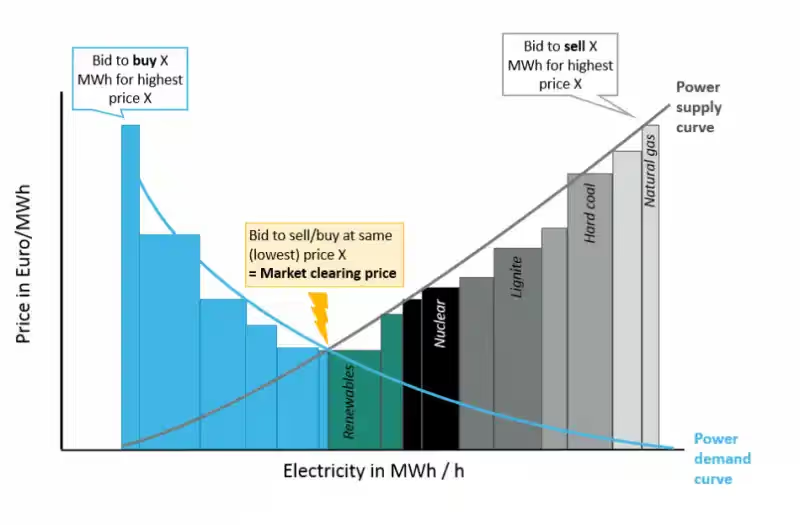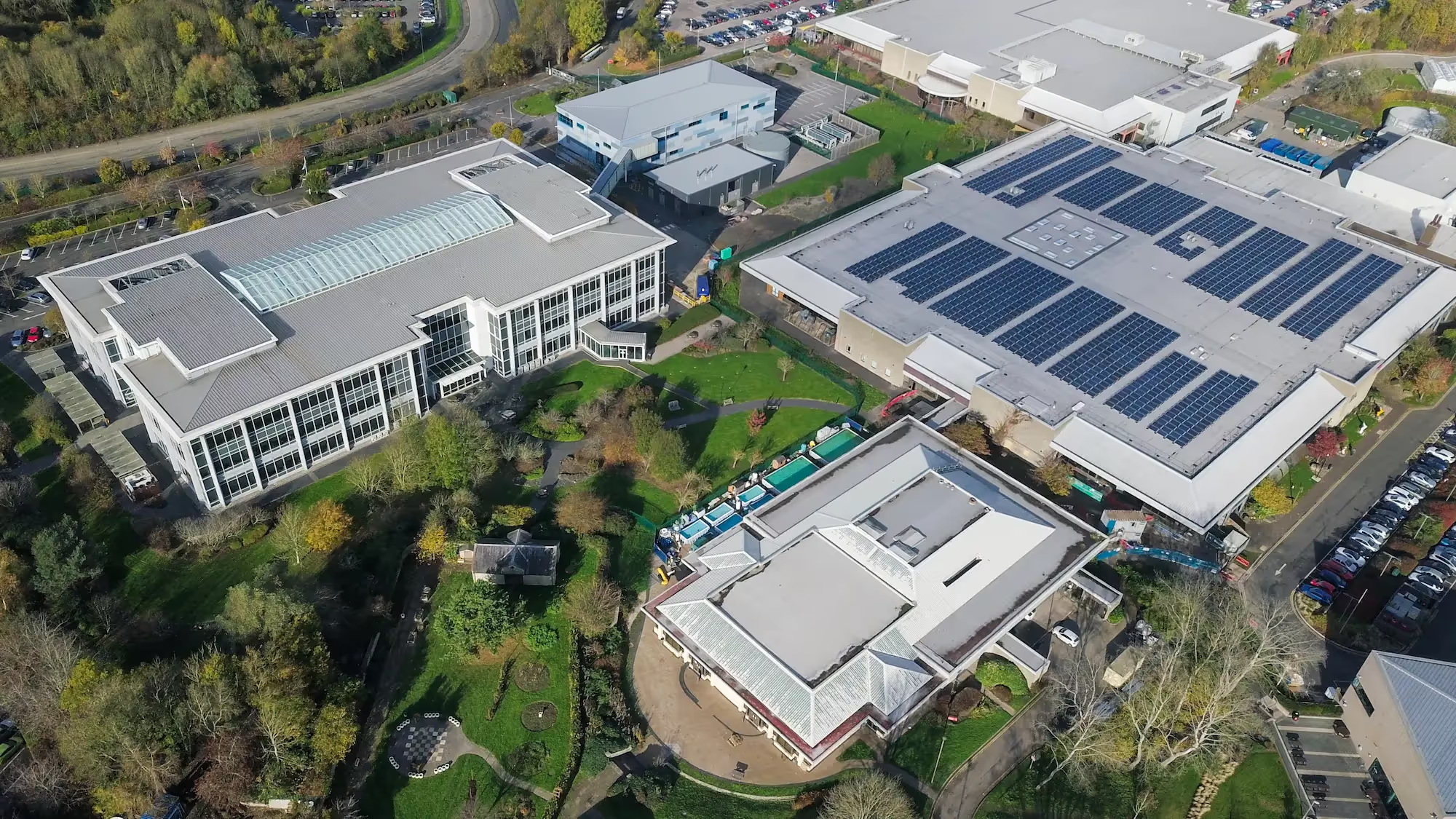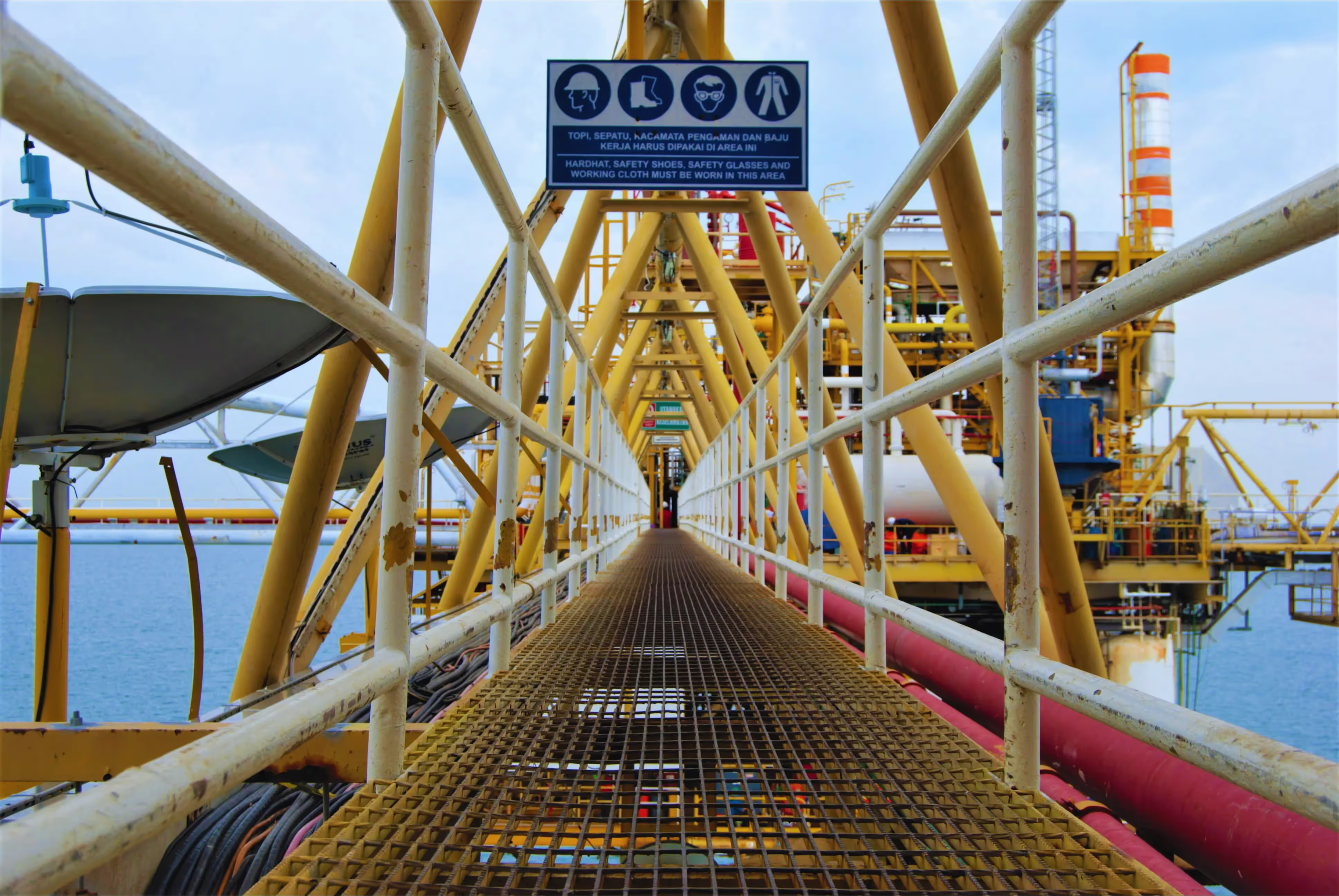How to prevent negative returns in renewable energy and solar
Most of the problems the renewable energy market face right now boil down to imbalances in the grid that result in a volatile spot market with negative renewable energy prices. This leads businesses in renewable energy to face negative returns on their power generation. The good news: you can prevent this, but it will require sub-second calculations “on” your assets, i.e. at the edge, instead of relying solely on cloud computing.

Imagine this: there are solar farms out there, right now, generating clean, renewable energy. But instead of getting paid for the solar energy they generate, they have to pay to get rid of it. How’s that for a world turned upside down?
See, most of the problems businesses in the renewable energy sector face right now are simultaneously more simple and far-reaching than you’d expect. Basically, most of these problems boil down to imbalances in the grid that result in a volatile spot market with negative renewable energy prices.
This leads businesses in renewable energy to face negative returns on their power generation. The good news: you can prevent this, but it will require sub-second calculations “on” your assets, i.e. at the edge, instead of relying solely on cloud computing.
Below, we’ll run you through some of the ways in which businesses in renewable energy can prevent negative returns.
Businesses in renewable energy and solar are losing potential revenue
Right now, renewable energy businesses are leaving massive amounts of potential revenue on the table. This isn’t just bad for these businesses, it’s bad news for all of us. Why? Because leaving revenue on the table threatens the continuity of these energy providers.
You see, the world – and Europe in particular – needs continuity and reliability in the renewable energy sector to achieve its goal of net zero by 2050. And with the renewable energy sector steadily growing, these threats to the continuity of businesses in solar are only going to get worse.
As for the statistics on that growth: global solar photovoltaic (PV) capacity is projected to hit 1290 GW by 2030. Which is great news for the planet, but also means higher amounts of potential lost revenue due to inefficiencies and volatile spot markets.
To give you some context of the current situation: in 2023, global PV capacity was 411GW. In 2024, the neutral expectation is a capacity of 474GW. That’s a YoY increase of 16%, but also means higher amounts of potential lost revenue, if we do not equip renewable energy assets with the right control and software.

This problem of potential lost revenue is relatively new, but also acute and urgent. And solutions aren’t necessarily implemented well across the industry. Take PV curtailment, for example. As of March 2024, across markets worldwide, average curtailment rates for solar are generally quite low, often around 3%.
Please note that the above statistic is something of a double-edged sword. PV curtailment should be a last resort to minimize negative returns and keep the grid in balance. The goal, eventually, is to curtail the least amount of energy possible, and generate energy more efficiently, instead.
Let’s take a closer look at the root causes of these imbalances in the grid and the volatile spot market they result in.
The cause: imbalances in the grid
The primary cause of negative returns and revenue loss in renewable energy and solar is the volatile energy spot market. In regions like the Netherlands and Europe, renewable energy generation and consumption do not always align, leading to significant imbalances.
These imbalances translate into fluctuating prices for renewable energy. In some cases, prices can even flip to negative prices, meaning that renewable energy businesses are paying money to offload their energy to the grid, instead getting paid for what they generate.
The trend, here, used to be that negative pricing occurred mainly in summer. However, this trend has shifted and negative pricing now also occurs both earlier and later in the year, extending the total period in which negative pricing occurs.
As a result, the amount of hours with negative prices has almost doubled in 2024, compared to 2023. Next year, this trend will only continue, with an even higher amount of hours where renewable energy prices are expected to flip negatively.
Market dynamics of the energy spot market
These market dynamics are inherent in the energy spot market: this market experiences heavy fluctuations where renewable energy generation often exceeds consumption, especially in the case of renewable sources like solar or wind power.
This is quite the opposite of how traditional energy markets based on fossil fuels work. In the case of renewable energy, businesses are quite dependent on several external factors. Let’s dig a little deeper into how this works.
Renewable energy generation (supply) vs consumption (demand)
Renewable energy sources, like solar farms, generate electricity based on weather conditions rather than demand, creating mismatches. Let’s show you a clear, tangible (yet somewhat simplified) example:
Most solar energy is generated at the time when the sun is at its peak. Most energy consumption takes place after office hours. This leads to imbalances between supply and demand. And you can imagine how the same goes for wind farms and their dependence on a natural phenomenon like the wind.
The causes and effects of negative power prices
These imbalances, in turn, lead to negative power prices, forcing producers to pay to offload excess electricity during off-peak hours. Can you imagine that: instead of making revenue on the energy you generate, you actually have to pay to get rid of it.
Add to that the existing infrastructure limitations, with power grids that struggle to efficiently transport electricity during peak renewable energy generation times, and this volatility in the energy spot market only gets worse.

All of these factors combined lead to a lot of lost revenue for businesses in renewable energy and solar. So how should you go about preventing this lost revenue, then?
How to prevent losing revenue in renewable energy and solar
Although we’ve painted quite a bleak picture, so far, all is not lost. There are several ways in which you can prevent your solar or wind farms from generating negative returns.
Key, here, is proper grid balancing and (market-based) congestion management. With the right congestion management strategies, you’ll be able to minimize the harmful effects of the volatile energy spot marketing on your renewable energy or solar business. We’ll outline the following strategies below:
- Solar / wind curtailment
- Aligning renewable energy generation with market dynamics
- Creating local smart grids
Congestion management
Congestion management, in the PV and renewable energy sector, refers to strategies and methods used to optimize the use of electricity grids when there is high penetration of renewable energy sources.
Here are some effective congestion management strategies that can help prevent revenue loss in the renewable energy sector.
1. Smart management through solar / wind curtailment
In the context of solar, wind, or renewable energy, "curtailment" refers to the intentional reduction in the output of renewable energy sources, below what they are capable of producing.
To implement curtailment you’ll need to use a control system like Helin to signal renewable energy installations to stop generating energy when prices are negative or grid congestion occurs. This lets you avoid the costs associated with negative energy prices.
Curtailment does mean that potential renewable energy generation is wasted. However, it is sometimes necessary to maintain grid stability and reliability. Here are some of the best software solutions that can help with PV & energy curtailment.
2. Aligning asset generation with market dynamics
Another way to effectively manage congestion is by aligning asset generation with market dynamics. This means you’re actively adjusting generation based on market signals, in order to optimize energy production.
Here’s how this works: by generating energy when it is most needed, the risk of producing excess energy during low-demand periods is reduced. Market prices offer an extremely effective feedback loop to indicate demand. We call this market-based congestion management.
3. Creating local smart grids
Curtailment and market-based congestion management are decent solutions to our problem. But there is a solution available right now that is significantly better at optimizing renewable energy generation and preventing negative returns: creating local smart grids.
These grids will balance supply and demand on an extremely local level, meaning at the level of the renewable energy asset itself. Balancing supply on a local level requires sub-second adjustments of your production (and storage) to the actual demand.
These sub-second calculations drive the need to do the calculations "on" the assets as cloud computing will be too slow (mainly driven by network communication overhead) to keep up with the need. As a result, edge computing is required to make this work.
The only way to do this, right now, is by making use of an industrial edge computing solution like Helin.
Example of how Helin creates an ecosystem of generation and consumption:
Imagine you have a solar roof on top of a warehouse. The warehouse consumes the electricity generated by the solar roof. Any excess energy is stored in a battery energy storage system (BESS). Should generation be too low for the desired consumption, grid electricity is used instead. Helin’s edge computing solution manages all of this.
As a matter of fact, the business case for a BESS is very interesting. A BESS can also be charged with grid electricity, which makes a lot of sense when spot market prices are low. Vice versa, the electricity stored in a BESS can be sold on the spot market when prices are high.

As of yet, there are no other ways except edge computing to provide accurate intelligence at scale and process signals at a speed required for something as volatile as the energy spot market. Especially for an industry that consists of a complex and varied collection of industrial assets like the renewable energy sector.
Basically, the energy grid, one of the most complex systems ever built, requires split-second decisions to maintain stability. AI in combination with edge computing is currently the only technology capable of processing vast amounts of data and making real-time decisions to manage the grid effectively.
AI and ML are crucial new tools available to help us predict energy consumption, optimize grid operations, and maintain system reliability for renewable energy sources like wind and solar power.
Benefits of congestion management for generators, grid operators and BRP/BSP/CSP
Congestion management isn’t just beneficial for businesses in renewable energy and solar trying to prevent negative returns and minimizing revenue loss. Other parties that should consider proper congestion management their highest priority:
- Grid operators
- Balance responsible parties (BRP)
- Balance service providers (BSP)
- Congestion service providers (CSP)
Adding smart controls to renewable energy assets makes them flexible, which isn't just beneficial for asset owners and operators trying to prevent negative returns, but it also creates huge benefits for grid operators.
It ensures a more stable and efficient energy system, reducing the risk of negative prices and improving overall grid reliability. And this is exactly what the world needs if we’re going to try and achieve net zero by 2050.
The catch: dealing with a variety of assets, hardware and protocols
We already touched on this briefly, but the renewable energy sector is renowned for consisting of highly varied industrial assets, built up slowly over the years. Most businesses in PV, for instance, will handle several sites, all of which will be made up of a variety of industrial hardware.
This presents these businesses with quite a challenge. It’s highly likely that these assets and pieces of hardware will be managed using a variety of protocols, as well. Meaning implementing your congestion management strategies can be a huge headache. Not ideal.
The solution: integrating your assets in a unified system
The renewable energy sector, as a whole, is at risk of not being able to keep up with market demands, regulatory requirements and technological advances elsewhere.
If this industry wants to tackle congestion management in an efficient way and work towards building local smart grids, it will need to find ways to integrate all its individual assets into a unified system.
And we’re not the only ones advocating for modernization in the industry. One of the EU’s policy recommendations for the solar industry reads that grids and flexibility investments should be taken to the next level. Grid operators, especially, should be taking steps to modernize and digitalize their operations.
In the EU Market Outlook for Solar Power 2023 - 2027 it states: “Grid operators also need to speed up the rollout of smart grid technologies and Big Data analytics infrastructure.”
But it’s not just grid operators who should invest in these types of technology. Individual renewable energy businesses also need to integrate their assets into unified systems, in order to turn industrial intelligence into positive returns and continuity for their organizations.
Helin’s API-based PV curtailment module
One way to start digitizing your solar energy business is to try out Helin’s API-based PV curtailment module, part of our Smart Grid Manager solution. The Smart Grid Manager is plug-and-play middleware that enables creating local smart grids by combining generation and consumption data.
In the case of PV, this system connects your solar farm to your asset and energy management systems.
Apart from general asset data management, the Smart Grid Manager comes with a specific PV curtailment module.
This module enables you to connect with all assets using only one (1) single API that easily integrates with the systems used to execute trading strategies, like a 3rd party EMS, enables curtailment in the inverters and changing battery setpoints.
This allows you to prevent negative returns during negative electricity prices, based on day ahead as well as intra day trading.
Added bonus: generators operating in the EU that received their license as of 2024 are required to use a real-time interface (RTI) as per the Requirement for Generators (RfG) legislation that went into effect in January 2024. Sites that were already active in 2023 don’t need RTI just yet, although these will fall in scope in 2026.
Helin’s Smart Grid Manager comes with such an RTI, meaning your PV business is fully compliant with the European RfG legislation.

Get started with Helin’s edge intelligence platform for renewables and solar
Are you ready to stop leaving valuable revenue on the table and start preventing negative returns for your renewable energy or solar business? Do your installations consist of a disparate mix of assets that require a variation of data protocols to manage?
If so, you might want to consider implementing Helin’s industrial edge intelligence platform. Use the Smart Grid Manager to optimize the production of your solar farm. Turn your legacy assets into ‘smart’, secure and sustainable powerhouses.
Want to learn more? Make sure to get in touch for a introduction call to discuss the entire Helin platform, including the Smart Grid Manager module.
Want to read more?
Stay up to date with the latest trends and developments on the topic of industrial edge computing, monitoring and intelligence.
Get real-time insights
into your remote assets
Combine local artificial intelligence with a centrally managed data infrastructure for more accuracy, reduced congestion on your network and lower costs.













